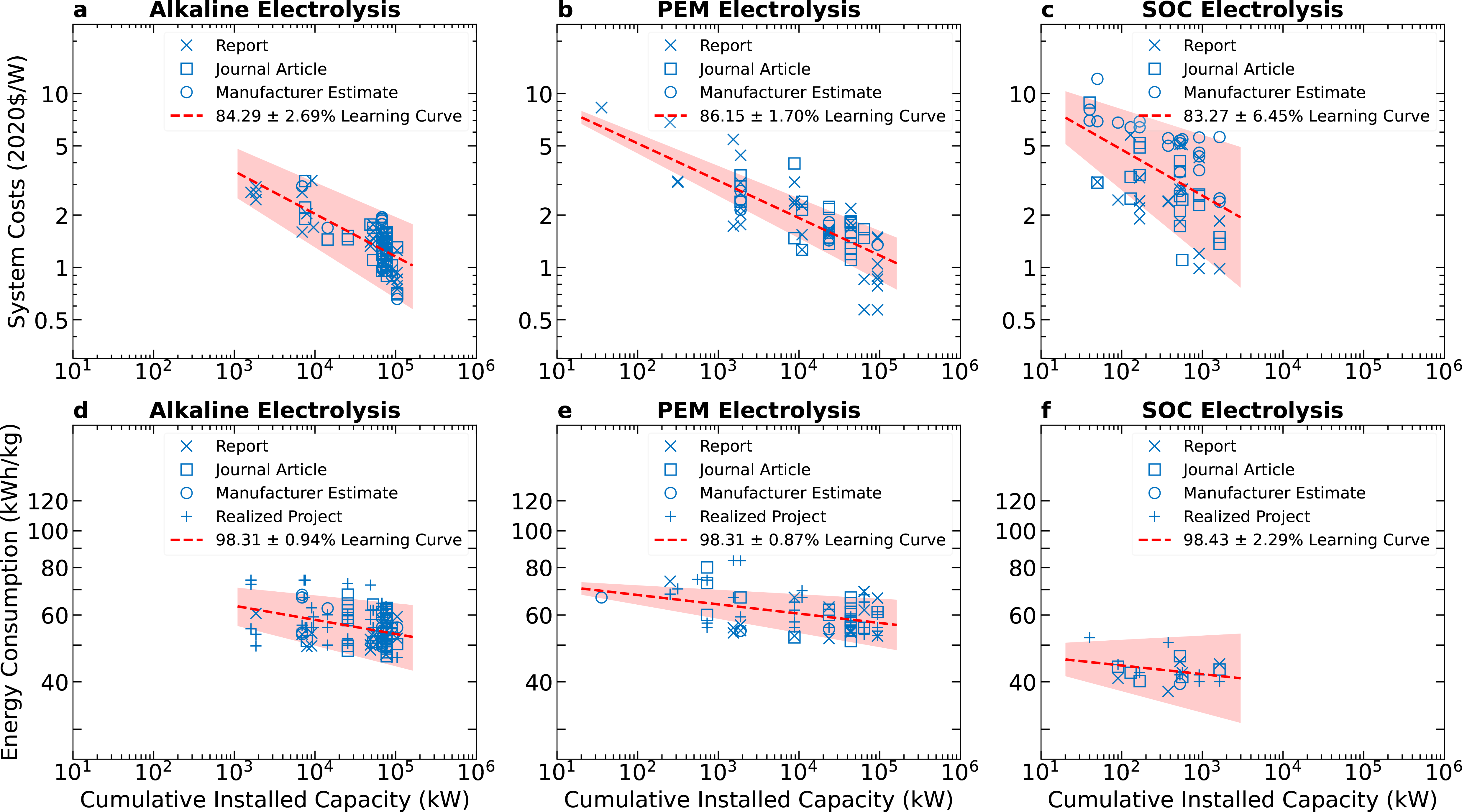CEEPR Working Paper
2023-09, April 2023
Gunther Glenk, Philip Holler, and Stefan Reichelstein
In the intensifying debate about alternative pathways for rapid decarbonization, hydrogen is increasingly viewed as a critical building block for storing and flexibly dispatching large amounts of carbon-free energy1;2. Among alternative hydrogen production technologies, Power-to-Gas (PtG) in the form of electrolytic hydrogen has received particular attention3–5. Large-scale deployment of these technologies, however, is generally expected to hinge on substantial cost declines and energy conversion improvements. To accelerate the pace of these improvements, governments around the world have recently introduced sizeable regulatory initiatives and subsidy programs for the development, deployment, and manufacturing of hydrogen equipment6;7.
This paper projects cost and conversion efficiency improvements for three prevalent PtG technologies: alkaline, polymer electrolyte membrane (PEM), and solid oxide cell (SOC) electrolysis. Our analysis is grounded in a learning-by-doing model that postulates that system prices for electrolyzers and their conversion efficiency decline at a constant rate with every doubling of cumulative installments of the technology in question. Such learning models have proven highly descriptive in the context of solar photovoltaics, onshore wind turbines, or lithium-ion batteries. Scarcity of data has so far limited the estimation of learning curves to alkaline electrolysis or to a single equipment manufacturer. Some earlier studies estimate the rate of past cost declines of PtG technologies against time or rely on expert opinions about future cost developments.
Our analysis provides a comprehensive assessment of the dynamics in system prices and energy efficiency for the three PtG technologies by tracking global observations on investment expenditures and energy consumption. This information is linked to capacity installations at facilities commissioned worldwide between 2000–2020. Our estimates return significant and robust learning curves for system prices in the range of 83–86% (Figure 1). Thus, system prices declined by 14–17% compared to the price levels prior to the doubling of cumulative installments. The relatively young SOC technology is projected to show the sharpest price decline at a 17% learning rate. PEM electrolyzers, in contrast, have experienced high capacity growth and a rapid price decline between 2003 and 2020. Here, our estimates yield a relatively slow learning rate of 14%. For conversion efficiency, we estimate that every doubling of cumulative installed capacity reduces the required kilowatt-hours (kWh) per kilogram (kg) of hydrogen produced by approximately 2% across all three technologies.
Our regression results can be extrapolated to yield forecasts for the system prices and conversion efficiencies of the three PtG technologies in question by the year 2030. Even for divergent growth forecasts issued by different industry and policy sources, the extrapolated values fall into a relatively narrow range. These calculations, in turn, lead us to conclude that the Hydrogen Shot target by the U.S. Department of Energy 7 of producing clean hydrogen at a cost of $1.0/kg by 2030 is ambitious but not unrealistic. Because electricity prices will become the dominant component of the life-cycle cost of hydrogen by 2030, the attainment of the Hydrogen Shot target via electrolytic hydrogen ultimately hinges on the availability of inexpensive and clean electricity.

Figure 1: Estimates of learning curves. This figure plots the global system prices in 2020 $US against the global cumulative installed capacity together with our estimates of the corresponding learning curves for (a) alkaline, (b) PEM, and (c) SOC electrolyzers. The figure also plots the energy consumption against the global cumulative installed capacity together with our estimates of the corresponding learning curves for (d) alkaline, (e) PEM, and (f) SOC electrolyzers. Areas shaded in red represent 95%-confidence intervals.
References
[1] Staffell, I. et al. The role of hydrogen and fuel cells in the global energy system. Energy & Environmental Science 12, 463–491 (2019).
[2] Davis, S. J. et al. Net-zero emissions energy systems. Science 9793 (2018).
[3] Sepulveda, N. A., Jenkins, J. D., Edington, A., Mallapragada, D. S. & Lester, R. K. The design space for long-duration energy storage in decarbonized power systems. Nature Energy (2021).
[4] Guerra, O. J. et al. The value of seasonal energy storage technologies for the integration of wind and solar power. Energy & Environmental Science (2020).
[5] Ueckerdt, F. et al. Potential and risks of hydrogen-based e-fuels in climate change mitigation. Nature Climate Change (2021).
[6] Repowereu: A plan to rapidly reduce dependence on Russian fossil fuels and fast forward the green transition (2022).
[7] U.S. Department of Energy. Secretary Granholm launches hydrogen energy earthshot to accelerate breakthroughs toward a net-zero economy (2021).





